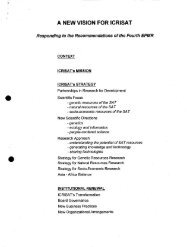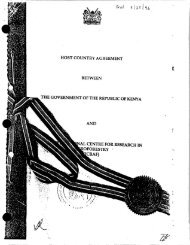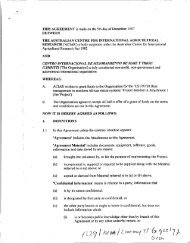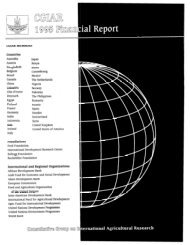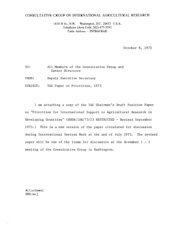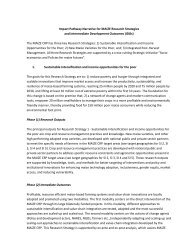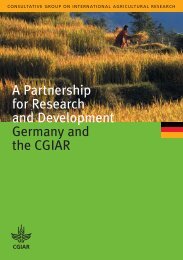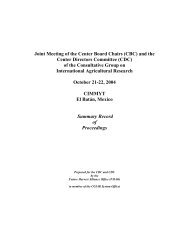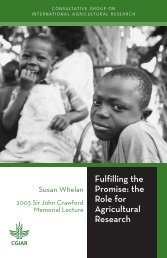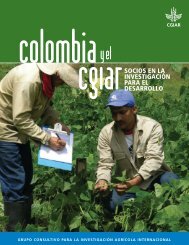CONSULTATIVE GROUP ON INTERNATIONAL ... - CGIAR Library
CONSULTATIVE GROUP ON INTERNATIONAL ... - CGIAR Library
CONSULTATIVE GROUP ON INTERNATIONAL ... - CGIAR Library
You also want an ePaper? Increase the reach of your titles
YUMPU automatically turns print PDFs into web optimized ePapers that Google loves.
<strong>C<strong>ON</strong>SULTATIVE</strong> <strong>GROUP</strong> <strong>ON</strong> INTERNATI<strong>ON</strong>AL AGRICULTURAL RESEARCH<br />
1818 H St., N.W. Washington, D.C. 20433 U.S.A.<br />
Telephone (Area Code 202) 477-3592<br />
Cable Address - INTBAFRAD<br />
FROM:<br />
The Secretariat<br />
CG/83/07<br />
April 21, 1983<br />
Consultative Group Meeting<br />
Paris, May 25-Z/, 1983<br />
Aaenda Item 10<br />
Attached is a copy of a paper entitled "Impact of <strong>CGIAR</strong> Institutes:<br />
Study Proposal." It is for discussion under Agenda Item 10 at the May 25-27<br />
meeting of the Group in Paris.<br />
This paper draws on the wide ranging discussion of the proposed<br />
impact study that has taken place in the period since issuance of the Secretariat's<br />
circular on this subject dated January 15, 1983. The proposal is<br />
necessarily very selective, leaving aside many good ideas squeezed out<br />
because of limitation of time and resources.<br />
Issues for discussion:<br />
1. Is there a consensus on the schedule proposed, that is for a study to be<br />
completed in time for discussion at Centers Week in 1984<br />
2. Does the scope of the proposed study match the desires of the Group given<br />
the constraints of time and resources which we face Are any aspects omitted<br />
which members find essential What are the lowest priority activities proposed<br />
which should be dropped if it proves necessary to cut back<br />
3. Is the chosen means of implementation (a small study team working closely<br />
with the <strong>CGIAR</strong> Secretariat, supervising and drawing from a range of contracted<br />
studies, relying heavily on information and assessments provided by<br />
the centers) acceptable<br />
4. Does the cost appear reasonable, and are the funds likely to be available<br />
from donors<br />
Attachment<br />
Distribution:<br />
CG Members<br />
TAC Chairman<br />
TAC Secretariat<br />
TAC Members<br />
Center Board Chairmen<br />
Center Directors<br />
/Continued...
-2-<br />
In relation to the last issue, three donors have pledged or provided<br />
funds as of April 18, 1983 in an amount totalling just over $250,000.<br />
This is less than a quarter of the sum required. It is assumed that many<br />
donors are waiting for the May meeting, or for more detail on the study,<br />
before announcing commitments. Indication of donor intention at the May<br />
meet i ng will be very desirable.<br />
In considering the proposal, members of the Group should be aware<br />
that there will inevitably be some adjustments in the course of implementation<br />
What would be most useful, therefore, would be guidance of a relative<br />
i y general sort, rather than an attempt to amend the proposal in detail.
THE IMPACT OF <strong>CGIAR</strong> INSTITUTES<br />
- Study Proposal. -<br />
ABSTRACT<br />
The impact of the International Agricultural Research<br />
Centers (IARCS) on the growth of agriculture in the developing<br />
countries is to be studied. Given that national institutions<br />
have the primary responsibility for the applied research and<br />
extension that actually lead to production increases, the<br />
proposal focuses on two interrelated aspects of the issue: the<br />
contribution of <strong>CGIAR</strong> institutes to building the capacity of<br />
national research, and the contribution to increasing food<br />
production of improved agricultural technology with which the<br />
IARCs have been associated. Data for the study will necessarily<br />
come in large part directly from the IARCs themselves. Other<br />
major sources will be (1) a survey of national agricultural<br />
researchers, (2) reviews of existing research reporting on<br />
yields, benefits and their distribution, (3) an updating of<br />
aggregate statistics on the spread of crop varieties derived from<br />
centers activities, (4) studies on the likely impact of<br />
technologies still in the pipeline.<br />
April 21, 1983
-2-<br />
INTRODUCTI<strong>ON</strong><br />
At the November 1982 meeting of the <strong>CGIAR</strong> it was suggested that<br />
the CG Secretariat organize a study of the impact of the centers on<br />
agriculture in developing countries. The discussions that took place at<br />
that time made it clear that various members of the Group had two.<br />
interrelated purposes in mind for the study. The first and most important<br />
was to collect specific and concrete evidence on the contribution that the<br />
work of the <strong>CGIAR</strong> was making to the achievement of development goals in<br />
agriculture and rural development. The second was to provide information<br />
that would help in establishing an overall strategy for the activities<br />
supported by the <strong>CGIAR</strong>.<br />
Subsequent to the November meeting the CG Secretariat drafted a<br />
memorandum on the impact study that was circulated to donors, center<br />
directors, and other interested professionals. Two brainstorming meetings<br />
of one day duration were held: in Washington, D.C. on February 22 and in<br />
Rome on March 16. About 50 persons participated in the two meetings,<br />
providing their insights and opinions on the important issues that should<br />
be covered in such an impact study. In addition, written reactions to the<br />
Secretariat's memorandum were prepared by most of the centers and a number<br />
of donors.<br />
Based on these consultations the Secretariat has prepared the<br />
current proposal for the consideration of the Group. It does not attempt<br />
to include all of the ideas that have been elici,ted through the process<br />
described for several reasons. On the practical side, the Group has<br />
clearly indicated the need for a substantive product by November 1984.<br />
This time constraint limits, to a certain extent, the type of activities<br />
that can be undertaken. Another practical limitation is the need to phrase<br />
questions in a way that yields specific and concrete results, thereby<br />
limiting the scope for theoretical studies. In addition, issues related to<br />
strategic planning of the centers system per se are the responsibility of<br />
the TAC and therefore will not be directly addressed in the impact study.<br />
OBJECTIVES<br />
The broad objective of the study is to determine the impact of<br />
the <strong>CGIAR</strong> institutes (the centers) on agricultural production in the<br />
developing countries. Aside from measurement and definitional problems,<br />
which are discussed below, there are major practical difficulties in<br />
achieving this objective: (1) because the international centers'<br />
technologies must flow through national research systems, which make major<br />
contributions of their own, it is difficult to separate the impact of<br />
center research from other research; since partnership with national<br />
research agencies is a key operating principle of the <strong>CGIAR</strong>, it would also<br />
be undesirable to separate out a distinct CG contribution, even if it were<br />
possible; (2) making the discoveries that lead to improved technology takes<br />
time and often depends on a background of previous research; some centers
-3-<br />
have been in existence for too short a time to have produced technologies<br />
for possible adoption, and/or are working on crops or problems where very<br />
little previous research exists; and (3) the existence of an "improved<br />
technology" is only a necessary condition for increasing production; if<br />
there is no means of informing farmers about the technology or if other<br />
factors make the use of that technology impossible or economically<br />
unattractive to farmers, this may limit application but not reflect failure<br />
on the part of agricultural research.<br />
The specific objectives of the study have been drawn to accommodate<br />
these constraints. The objectives include the following:<br />
1. To measure the contribution of <strong>CGIAR</strong> centers to the capacity of<br />
national research systems to develop improved agricultural technology.<br />
Specifically, to:<br />
1.1 show the extent to which genetic material, research<br />
approaches, agronomic techniques, and other ideas developed<br />
in association with or promoted by CG institutes have been<br />
adopted by national researchers.<br />
1.2 describe and evaluate the training of national researchers<br />
by the CG institutes.<br />
1.3 obtain and interpret a subjective evaluation by developing<br />
country researchers and research managers of the<br />
contribution of centers to national agricultural research<br />
productivity.<br />
2. To assess the impact of improved agricultural technology<br />
(specifically of those technologies with which the centers have been<br />
associated) on food production in developing countries. Specifically, to:<br />
2.1<br />
2.2<br />
2.3<br />
2.4<br />
measure the spread of crop varieties developed by or in<br />
association with CG centers or developed from genetic<br />
materials supplied under their exchanges.<br />
summarize evidence on the yield and income benefits of crop<br />
varieties developed in association with centers activities.<br />
summarize the results of studies evaluating the impact of<br />
agricultural technology -- particularly technology developed<br />
in connection with the centers -- on income distribution and<br />
employment in developing countries.<br />
look at the relationship between national and international<br />
expenditures on agricultural research and on extension and<br />
agricultural production using an input-output approach and<br />
data for a broad cross-section of developing countries with<br />
the purpose of assessing the degree of complementarity of<br />
national and CG resources.
-4-<br />
3. To obtain an inventory of technology under development in CG<br />
institutes and a projection of the likely production gains that would<br />
result from their successful development, as well as estimates of their<br />
implications for resource use.<br />
4. To portray the role of CG institutions within the world<br />
agricultural system, especially with respect to:<br />
4.1 resources used in <strong>CGIAR</strong> institutions compared to those used<br />
in national research systems.<br />
4.2 realistic expectations of the time when CG institute<br />
activities will pay off.<br />
4.3 the ability of technological change to affect social and<br />
institutional problems.<br />
METHODOLOGY<br />
The diverse set of objectives listed above require an equally<br />
diverse set of methodologies. No single research activity will be able to<br />
meet all the objectives and no single discipline has a monopoly on the<br />
methodology needed. The ideas discussed below on how to approach each<br />
sub-objective will have to be fleshed out in detail after the broad thrust<br />
- of the study has been approved.<br />
The final product would be a broad overview paper, drawing .<br />
together and interpreting the results of the work on each objective, plus<br />
summaries of the results of the individual research tasks.<br />
The study will take maximum advantage of research already<br />
completed, to avoid unnecessary expenditure of time and money. The <strong>CGIAR</strong><br />
Secretariat has asked IFPRI to prepare an extensive critical bibliography<br />
of relevant research materials, and to collect copies of such materials,<br />
for the use of the impact study.<br />
objectives<br />
A brief discussion on methodology for each of the four major<br />
follows:<br />
1. CG's Contribution to National Research Capacity<br />
The IARCs contribute to building national research capacity<br />
through collaborative research projects, formal degree and non-degree<br />
training programs, networks in which genetic materials, techniques and<br />
methodologies are exchanged, informal visits of scientists, workshops,<br />
conferences, and contracts for technical assistance to assist in building<br />
national systems. The contribution of these can be seen from the viewpoint<br />
of the centers as inputs provided to national programs or alternatively,<br />
from the viewpoint of the national researchers as resources obtained from<br />
the centers. In this study we propose that both viewpoints be utilized,
-5-<br />
but major emphasis will be placed on the viewpoint of the national<br />
researchers. The results of the studies described below will be combined<br />
to address the sub-objectives under this heading.<br />
a) Survey of Researchers. A sample of agricultural researchers<br />
in national programs will be interviewed to get a measure of the<br />
contribution of international activities to national research in the form<br />
of research methods and techniques, technical information, genetic<br />
materials and training.<br />
Each developing country that plays host to a center will be<br />
covered in the survey plus an equal number of other countries, making about<br />
20 in all. Within the countries, a small number of agencies conducting<br />
agricultural research will be selected, generally including the national<br />
center. This will keep travel at a reasonable level. Within each agency a<br />
random sample of agricultural researchers will be used so the results can<br />
be generalized. Interviewees will include research administrators in order<br />
to: (a) get their views on the issues, and (b) obtain information useful<br />
in sampling active researchers. However, emphasis will be placed on the<br />
information obtained from the sample of active researchers.<br />
All international contributions will be included in the survey,<br />
whether from the CG or another source, but the analysis will attempt to<br />
identify and assess the contributions with which any of the 13 centers are<br />
associated.<br />
b) Survey of Centers. Information on training obtained from the<br />
centers will complement the data obtained from national scientists. Each<br />
center will be asked for data on numbers trained including subject, level,<br />
country and present occupation of the trainee. This data will be collected<br />
and analyzed jointly with the TAC study of training, and the two will be<br />
combined, if practical, into a single study. At the same time the inputs<br />
of centers through conferences and workshops will be obtained. In<br />
addition, there would be an attempt to review the information services of<br />
the centers, and to look at the number and levels of people reached, the<br />
kinds of information communicated.<br />
c) Process Study. The process of developing new agricultural<br />
technologies is complex and may involve a long series of administrative and<br />
scientific exchanges between national and international researchers in<br />
addition to the research activities that go on in the national and<br />
international institutions. Documentation of this process for a selected<br />
technology, or technologies, in a selected set of 2-3 countries will<br />
provide insights that cannot be obtained in any other way.<br />
Technological innovations that have proceeded through the final<br />
stage of adoption will be selected. Their origins will be identified and<br />
the contributions of the various actors to the process of developing the<br />
innovation to the point where it was adopted will be traced. Special<br />
attention will be paid to the interactions between national and<br />
international researchers.
-6-<br />
d) Knowledge Transfers. Unlike genetic materials and research<br />
procedures, one cannot directly observe a flow of knowledge. But one can<br />
make a convincing argument that knowledge is one of the most important<br />
commodities the centers generate, especially in the more basic disciplines.<br />
An effort will be made to quantify the flow of knowledge from the<br />
CG system by examining the research papers of scientists in developing<br />
countries to determine their reported use of ideas developed at the CG<br />
centers.<br />
2. Impact of Improved Agricultural Technology on Food Production<br />
The contribution of improved agricultural technology to<br />
increasing food production has been documented in a large literature<br />
reviewed recently in a paper by Scobie (World Bank Staff Working Paper<br />
No. 361) and another by Schuh and Tollini (World Bank Staff Working Paper<br />
No. 360). These surveys and later research will be drawn on heavily under<br />
this objective.<br />
A wide variety of factors not related to the quality of researc<br />
affect the time required to arrive at a technology ready for application<br />
and also the speed with which application takes place. One such major<br />
factor is the amount of basic background work that has been done on the<br />
crop or the problem being addressed. Assessments of impact should take<br />
account of the availability of background research whenever dealing with<br />
the time required to make significant progress.<br />
:h<br />
Speed and breadth of application may be affected by the<br />
availability of supporting institutions, government policies, and a whole<br />
range of social, economic and cultural factors. These must be taken into<br />
account by centers and by the <strong>CGIAR</strong> in setting priorities, but the factors<br />
listed remain largely beyond the control of the <strong>CGIAR</strong> system. In this<br />
study, we do not propose to undertake any fresh research on these matters,<br />
but the assessment must take full account of them if it is to give a<br />
realistic picture of actual and expected impact.<br />
a) Spread of Rice, Wheat and Maize. Data on the spread of<br />
semi-dwarf wheltained from the most<br />
knowledgable sources in each country. This will be essentially an updating<br />
of Dalrymple's work. Similar information on the spread of maize varieties<br />
or hybrids associated with CIMMYT/IITA activities will be obtained. This<br />
will depend on: (a) an identification of the varieties/hybrids released in<br />
each country that have been derived from centers materials, along with the<br />
year in which each was released, and (b) an estimate of the hectarage<br />
planted to such varieties.<br />
The yield gain relative to traditional varieties of wheat, maize<br />
and rice will be estimated from information available in national<br />
statistics and from farm management research studies reported in the<br />
literature. Income benefits will be estimated from the literature showing<br />
relative inputs and yields.
-7-<br />
An attempt will also be made to identify the production share and<br />
location of wheat, maize and rice which are grown in developing countries<br />
under conditions to which the presently available high yielding varieties<br />
are unsuited. These data will help define the potential impact of the<br />
research already done on these crops, and the scope of what may need to be<br />
done in the future.<br />
b) New Varieties of Other Crops. Each center will be given the<br />
opoortunitv to document the spread and production imoact of new varieties<br />
of'crops other than rice, wheat and maize. Because the development of<br />
improved varieties in the other crops has occurred more recently than for<br />
rice and wheat it is anticipated that the total area may still be small and<br />
sources other than the official statistics may provide the best<br />
information.<br />
c) Spread of New Technologies. Centers will also be given the<br />
opportunity to document the spread and production impact of new management<br />
practices or farming systems innovations. Some care will have to be<br />
exercised to include only technologies that have been developed with<br />
contributions from the centers.<br />
d) Distribution of Benefits. Many questions have been raised<br />
about the distribution of benefits from the new varieties. One aspect of<br />
this question relates to the adoption of new varieties by farmers of<br />
different sizes or located in different agro-climatic regions. Another<br />
relates to labor used with different varieties. A summary will be made of<br />
the findings of past studies related to this issue for wheat and rice<br />
technology.<br />
A field study on the pattern of adoption of CIMMYT maize<br />
varieties will be undertaken in Mexico. It will identify the geographic<br />
spread of the varieties, and the relationship between agroclimatic<br />
characteristics and spread. In a number of selected regions where adoption<br />
has reached a moderate level it will determine the relationship between<br />
adoption and farm size or tenure or other socio-economic characteristic of<br />
farmers that may affect adoption.<br />
e) Research Productivity. The productivity of investment in<br />
national agricultural research and extension activities will be<br />
investigated for a cross-section of Asian, African and Latin American<br />
countries including some with large and some with small inputs from<br />
IARCs. In this approach, which uses aggregate production, input, and<br />
investment data, investment in agricultural technology improvement acts<br />
like an input in the production process. The measured contribution of<br />
research investment is derived from differences in the relative level of<br />
research investment across countries, so differences in the levels of<br />
production inputs must also be included in the analysis to avoid<br />
attributing more to technology than is warranted.<br />
By comparing the productivity of investments in technology<br />
improvement in countries with large inputs from CG institutes to the
-8-<br />
productivity in countries with small inputs from CG institutes it may be<br />
possible to say something about the complementary effect of CG activities<br />
on the productivity of national research and extension efforts.<br />
3. Likely Impact of Technology Being Developed<br />
The contribution of technology already in use by farmers is<br />
necessarily restricted to those commodities for which successful technologies<br />
have been developed -- i.e., wheat, rice and maize, with perhaps some<br />
contributions of farming systems research in Asia. There are some technologies<br />
that may ready for release to farmers in the near future, say<br />
within 5 years and many other that may be ready in more than 5 years. The<br />
study will estimate the likely impact of such technologies'by obtaining the<br />
best considered judgements of knowledgable individuals (the "Delphi"<br />
approach). Estimates of yield benefits and probabilities of success,<br />
together with the number of units affected and prices, can be used to<br />
generate monetary benefits. Those, together with estimates of the time<br />
involved can be used to estimate the present value of future benefits.<br />
This part of the study will also provide insight into the time<br />
dimensions within which research takes place and the results of research<br />
are applied. Specifically, this part should describe the variations in the<br />
amount of background knowledge that exists about various crops and research<br />
problems, in the length of time required for different research procedures,<br />
in field testing, and in the adaptation of results to the specific<br />
conditions in which they will be used. This context will form an<br />
invaluable background for the impact study as a whole.<br />
Because scientists at the centers are most familiar with the<br />
technologies under development, this part of the study will have to be<br />
conducted in close cooperation with the centers. Each center will be asked<br />
to identify the most important technologies on which it is working but<br />
which still require additional research or testing before being released.<br />
Centers will be asked to provide estimates of the yield or cost benefits,<br />
probability of success, area or number of head of livestock likely to be<br />
benefited, direct cost of technology use, socio-economic groups affected,<br />
and time until success is likely for each of the technologies. Obviously,<br />
the identification of the technologies included in this analysis will be an<br />
important step in the process. It would be desirable to include all the<br />
major technologies being developed, but in some centers that may involve<br />
such a large number of separate analyses as to be burdensome. It is<br />
unlikely that meaningful analyses on this issue can be conducted for IFPRI,<br />
ISNAR, and IBPGR.<br />
4. Role of <strong>CGIAR</strong> Institutions<br />
The purpose of this part of the impact study is to provide a more<br />
accurate picture of the actual and potential role of the <strong>CGIAR</strong> within the<br />
world agricultural research and development system. This involves the<br />
compilation and interpretation of data on research investment by both<br />
national systems and international donors. It involves a realistic
-9-<br />
appraisal and presentation of what may reasonably be expected from<br />
agricultural research, with special attention to the time required before<br />
practical technologies can be expected to result from research on various<br />
commodities. It also involves an examination of the limited short run<br />
capacity of technology to change the social and economic realities<br />
determined by institutional, economic, social, and political factors in the<br />
developing countries.<br />
These issues do not admit to any easy research approach. Instead<br />
they require careful, thorough synthesis of ideas and clear expression.<br />
They are among the more challenging issues in the impact study.<br />
5. Other Supporting Studies<br />
Additional, relatively small studies will undoubtedly be required<br />
to complete the picture of the centers' impact. One which has been<br />
specifically requested by several donors is a general assessment of the way<br />
in which centers deal with environmental issues arising out of their work,<br />
or closely related to the application of their results. Another is an<br />
appreciation of the value of collecting, evaluating and storing the full<br />
range of gemplasm that represents the living ancestors and relatives of<br />
present food and animal crops.<br />
ORGANIZATI<strong>ON</strong> OF THE STUDY<br />
It is proposed to organize the study as follows. The <strong>CGIAR</strong><br />
Secretariat will have overall responsibility for the study. A project<br />
director and two staff members will be appointed for the duration of the<br />
study. A number of institutions or individual researchers will be<br />
contracted to carry out those research activities that require additional<br />
personnel. The specific methodologies will be designed by the CG<br />
Secretariat and project director in consultation with an advisory committee<br />
of five members consisting of individuals with professional competence in<br />
agricultural development. Major inputs from the advisory committee will<br />
come during the planning of the study and in reviewing the methodology and<br />
preliminary findings. Consultants with specialized skills in the design of<br />
interview instruments may be engaged during the design of the study.<br />
The project director will be responsible for obtaining peer type<br />
assessments of materials submitted where he, the advisory committee, or the<br />
CG Secretariat think this is necessary. He will have the overall<br />
responsibility for drafting the final report.<br />
It is expected that the report will consist of an overview<br />
document covering and relating the important results, and copies or<br />
summaries, as appropriate, of the underlying research. The intention is to<br />
complete the study in time for it to be discussed at International Centers<br />
Week in 1984.
- 10 -<br />
BUDGET<br />
The following budget should be taken at this stage to represent<br />
only the range of costs with some idea of the distribution among the most<br />
expensive elements of the study as proposed:<br />
Component<br />
1. Contribution to National<br />
Research Capacity<br />
- survey of national<br />
researchers<br />
- process study<br />
2. Impact on Food Production<br />
Months of<br />
Researcher<br />
Time<br />
60<br />
16<br />
Estimated<br />
cost<br />
$ 500,000<br />
130,000<br />
- effects of improved maize<br />
on income distribution<br />
- research productivity<br />
3. Other Contracted Studies<br />
4. Study Staff<br />
9 70,000<br />
6 30,000<br />
10 50,000<br />
22 220,000 .<br />
5. Other Costs (advisory committees,<br />
consultants, travel for working<br />
meetings, etc.) 100,000<br />
6. Contingency 100,000<br />
TOTAL $1,200,000<br />
-=<br />
Except for the maize distribution project which might be done at<br />
CIMMYT, this budget provides no funds for the collection and analysis of<br />
information or for research done by centers. It assumes that all of the<br />
work not separately budgeted will be done by the study staff or by the<br />
centers.<br />
-



